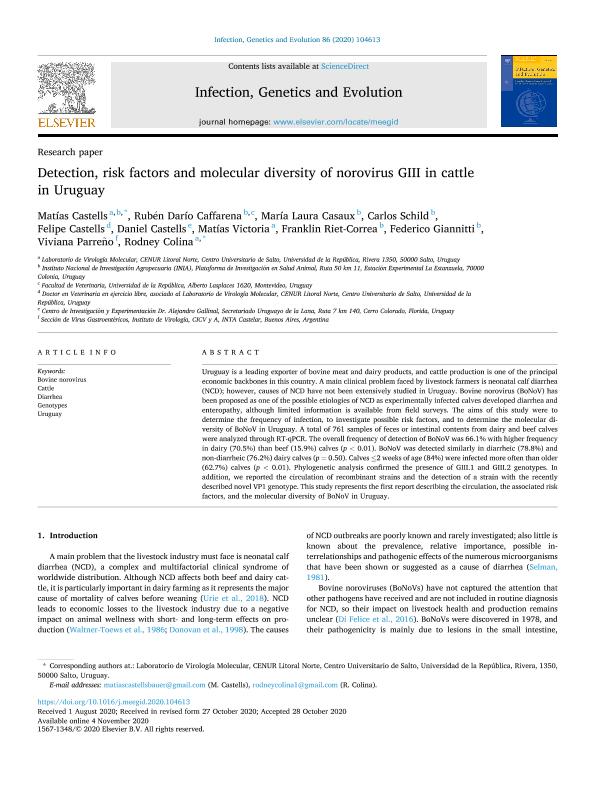Artículo
Detection, risk factors and molecular diversity of norovirus GIII in cattle in Uruguay
Castells, Matías; Caffarena, Rubén Darío; Casaux, María Laura; Schild, Carlos; Castells, Felipe; Castells, Daniel; Victoria, Matías; Riet Correa, Franklin; Giannitti, Federico; Parreño, Gladys Viviana ; Colina, Rodney
; Colina, Rodney
 ; Colina, Rodney
; Colina, Rodney
Fecha de publicación:
12/2020
Editorial:
Elsevier Science
Revista:
Infection, Genetics and Evolution
ISSN:
1567-1348
Idioma:
Inglés
Tipo de recurso:
Artículo publicado
Clasificación temática:
Resumen
Uruguay is a leading exporter of bovine meat and dairy products, and cattle production is one of the principal economic backbones in this country. A main clinical problem faced by livestock farmers is neonatal calf diarrhea (NCD); however, causes of NCD have not been extensively studied in Uruguay. Bovine norovirus (BoNoV) has been proposed as one of the possible etiologies of NCD as experimentally infected calves developed diarrhea and enteropathy, although limited information is available from field surveys. The aims of this study were to determine the frequency of infection, to investigate possible risk factors, and to determine the molecular diversity of BoNoV in Uruguay. A total of 761 samples of feces or intestinal contents from dairy and beef calves were analyzed through RT-qPCR. The overall frequency of detection of BoNoV was 66.1% with higher frequency in dairy (70.5%) than beef (15.9%) calves (p < 0.01). BoNoV was detected similarly in diarrheic (78.8%) and non-diarrheic (76.2%) dairy calves (p = 0.50). Calves ≤2 weeks of age (84%) were infected more often than older (62.7%) calves (p < 0.01). Phylogenetic analysis confirmed the presence of GIII.1 and GIII.2 genotypes. In addition, we reported the circulation of recombinant strains and the detection of a strain with the recently described novel VP1 genotype. This study represents the first report describing the circulation, the associated risk factors, and the molecular diversity of BoNoV in Uruguay.
Palabras clave:
BOVINE NOROVIRUS
,
CATTLE
,
DIARRHEA
,
GENOTYPES
,
URUGUAY
Archivos asociados
Licencia
Identificadores
Colecciones
Articulos (IVIT)
Articulos de INSTITUTO DE VIROLOGIA E INNOVACIONES TECNOLOGICAS
Articulos de INSTITUTO DE VIROLOGIA E INNOVACIONES TECNOLOGICAS
Citación
Castells, Matías; Caffarena, Rubén Darío; Casaux, María Laura; Schild, Carlos; Castells, Felipe; et al.; Detection, risk factors and molecular diversity of norovirus GIII in cattle in Uruguay; Elsevier Science; Infection, Genetics and Evolution; 86; 12-2020; 1-7
Compartir
Altmétricas



